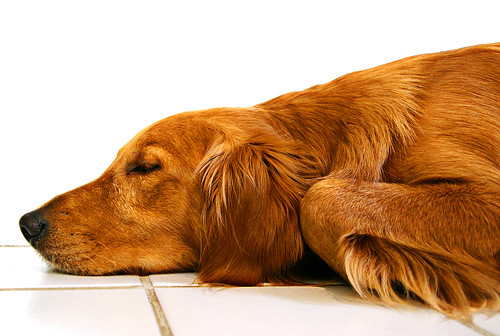The Golden Retriever is a breed of dog, historically developed as a gundog to retrieve shot waterfowl and upland game during hunting. As such they were bred to have a soft mouth to retrieve game undamaged and an instinctive love of water. Their intelligence and versatility sees them employed in a variety of roles including illegal drug detection, search and rescue, as hunting dogs and as guide dogs. Its friendly, eager-to-please and patient demeanor has made it one of the most popular family dogs (by registration) in the world.
The Golden Retriever was originally developed in Scotland at "Guisachan" near Glen Affric, the highland estate of Sir Dudley Marjoribanks (pronounced "Marʒbanks"), later Baron Tweedmouth. For many years, there was controversy over which breeds were originally crossed. In 1952, the publication of Majoribanks' breeding records from 1835 to 1890 dispelled the myth concerning the purchase of a whole troupe of Russian sheepdogs from a visiting circus.
Improvements in guns during the 1800s resulted in more fowl being downed during hunts at greater distances and over increasingly difficult terrain. This led to more birds being lost in the field. Because of this improvement in firearms, a need for a specialist retriever arose as training setter and pointer breeds in retrieval was found to be ineffective. Thus work began on the breeding of the Golden Retriever to fill this much needed role.
The Golden Retriever was originally developed in Scotland at "Guisachan" near Glen Affric, the highland estate of Sir Dudley Marjoribanks (pronounced "Marʒbanks"), later Baron Tweedmouth. For many years, there was controversy over which breeds were originally crossed. In 1952, the publication of Majoribanks' breeding records from 1835 to 1890 dispelled the myth concerning the purchase of a whole troupe of Russian sheepdogs from a visiting circus.
Improvements in guns during the 1800s resulted in more fowl being downed during hunts at greater distances and over increasingly difficult terrain. This led to more birds being lost in the field. Because of this improvement in firearms, a need for a specialist retriever arose as training setter and pointer breeds in retrieval was found to be ineffective. Thus work began on the breeding of the Golden Retriever to fill this much needed role.
The original cross was of a yellow-coloured Retriever, Nous, with a Tweed Water Spaniel female dog, Belle. The Tweed Water Spaniel is now extinct but was then common in the border country. Majoribanks had purchased Nous in 1865 from an unregistered litter of otherwise black wavy-coated retriever pups. In 1868, this cross produced a litter that included four pups; these four became the basis of a breeding program which included the Irish Setter, the sandy-colored Bloodhound, the St. John's Water Dog of Newfoundland, and two more wavy-coated black Retrievers. The bloodline was also inbred and selected for trueness to Majoribanks' idea of the ultimate hunting dog. His vision included a more vigorous and powerful dog than previous retrievers, one that would still be gentle and trainable. Russian sheepdogs are not mentioned in these records, nor are any other working dog breeds. The ancestry of the Golden Retriever is all sporting dogs, in line with Majoribanks' goals.
Golden Retrievers were first accepted for registration by the The Kennel Club of England in 1903, as Flat Coats - Golden. They were first exhibited in 1908, and in 1911 were recognized as a breed described as Retriever (Golden and Yellow). In 1913, the Golden Retriever Club was founded. The breed name was officially changed to Golden Retriever in 1920.
The Honorable Archie Majoribanks took a Golden Retriever to Canada in 1881, and registered Lady with the American Kennel Club (AKC) in 1894. These are the first records of the breed in these two countries. The breed was first registered in Canada in 1927, and the Golden Retriever Club of Ontario, now the Golden Retriever Club of Canada, was formed in 1958. The co-founders of the GRCC were Cliff Drysdale, an Englishman who had brought over an English Golden and Jutta Baker, daughter in law of Louis Baker who owned Northland Kennels, possibly Canada's first kennel dedicated to Goldens. The AKC recognized the breed in 1925, and in 1938 the Golden Retriever Club of America was formed.
Golden Retrievers were first accepted for registration by the The Kennel Club of England in 1903, as Flat Coats - Golden. They were first exhibited in 1908, and in 1911 were recognized as a breed described as Retriever (Golden and Yellow). In 1913, the Golden Retriever Club was founded. The breed name was officially changed to Golden Retriever in 1920.
The Honorable Archie Majoribanks took a Golden Retriever to Canada in 1881, and registered Lady with the American Kennel Club (AKC) in 1894. These are the first records of the breed in these two countries. The breed was first registered in Canada in 1927, and the Golden Retriever Club of Ontario, now the Golden Retriever Club of Canada, was formed in 1958. The co-founders of the GRCC were Cliff Drysdale, an Englishman who had brought over an English Golden and Jutta Baker, daughter in law of Louis Baker who owned Northland Kennels, possibly Canada's first kennel dedicated to Goldens. The AKC recognized the breed in 1925, and in 1938 the Golden Retriever Club of America was formed.





No comments:
Post a Comment